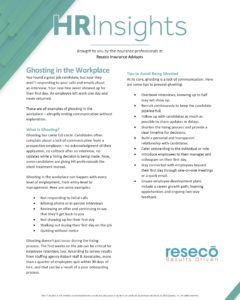
You found a great job candidate, but now they aren’t responding to your calls and emails about an interview. Your new hire never showed up for their first day. An employee left work one day and never returned.
These are all examples of ghosting in the workplace—abruptly ending communication without explanation.
What Is Ghosting?
Ghosting has come full circle. Candidates often complain about a lack of communication from a prospective employer—no acknowledgment of their application, no callback after an interview, no updates while a hiring decision is being made. Now, some candidates are giving HR professionals the silent treatment instead.
Ghosting in the workplace can happen with every level of employment, from entry-level to management. Here are some examples:
- Not responding to initial calls
- Missing phone or in-person interviews
- Reviewing an offer and continuing to say that they’ll get back to you
- Not showing up for their first day
- Walking out during their first day on the job
- Quitting without notice
Ghosting doesn’t just occur during the hiring process. The first weeks on the job can be critical for employee retention, too. According to survey results from staffing agency Robert Half & Associates, more
than a quarter of employees quit within 90 days of hire, and that can be a result of a poor onboarding process.
Tips to Avoid Being Ghosted
At its core, ghosting is a lack of communication. Here are some tips to prevent ghosting:
- Overbook interviews, knowing up to half may not show up.
- Recruit continuously to keep the candidate pipeline full.
- Follow up with candidates as much as possible to share updates or delays.
- Shorten the hiring process and provide a clear timeline for decisions.
- Build a personal and transparent relationship with candidates.
- Cater onboarding to the individual or role.
- Introduce employees to their manager and colleagues on their first day.
- Stay connected with employees beyond their first day through one-on-one meetings or a quick email.
- Ensure employee development plans include a career growth path, learning opportunities and ongoing two-way feedback.
What Should You Do?
It’s unknown whether ghosting is a trend that’s here to stay in the workplace. Every situation is different, but if you find yourself being ghosted by a candidate or employee, start with adjusting your hiring and onboarding process using the tips above.
By building strong talent communities and engaging new hires early and often, you can better position yourself to reduce the chances of candidates and employees ghosting you.
Contact us for more documents on employee engagement and hiring.
This HR Insights is not intended to be exhaustive nor should any discussion or opinions be construed as professional advice. © 2020 Zywave, Inc. All rights reserved.


